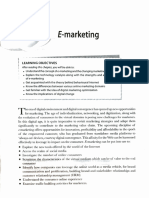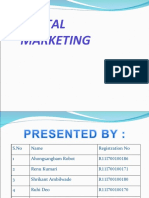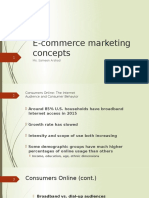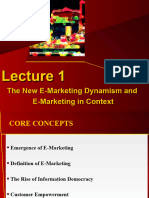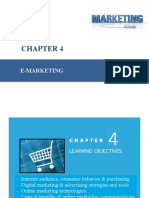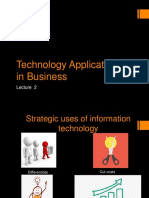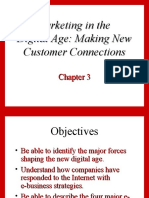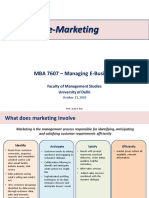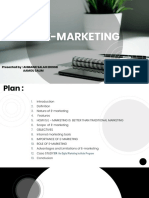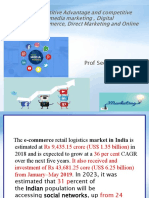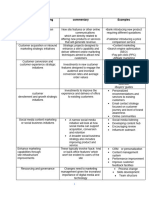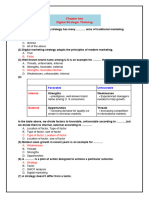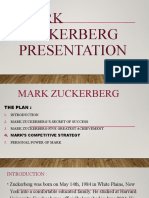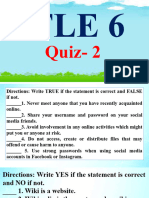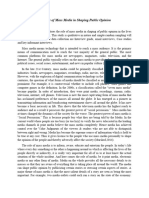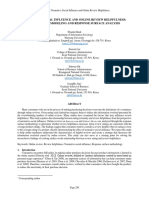Marketing implications of internet technology
Web 1.0 is the past of e-marketing
Personalisation
Connecting a database to a Web site allows for individually targeted offers
The more consumers and businesses buy, the better the data and more effective the marketing
One-to-one marketing
Gain instant access to individual customers on computers and mobile phones
More interesting campaigns
Use creative multimedia content to engage customers
Better conversion rates (increased purchases)
Online customers are only a few clicks from a purchase
when offline they must make a phone call or visit a store
online conversion rate is higher than offline
Twenty-four-hour marketing
Allows 24/7 access to the firm’s products and services, even when the office is closed
the internet’s unique properties
1. Lower costs: Reach the right customers at a much lower cost
2. Trackable: Obtain detailed data about customer responses to marketing campaigns
3. Global reach: Access new markets across the globe
Web 2.0 is the present of E-marketing
Internet adoption matures
Online retail sales mature
Search engines are now reputation engines
Relevance is one of Google’s search algorithm variables. The more high-traffic, similar-topic Web
pages that point to a site, the higher it appears on search engine results pages (SERPs)
Image recognition takes root: is a technology that sees the content within an image
Improved online and offline strategy integration
offering customers more than one way to buy something
Intellectual capital rules
Imagination, creativity, and entrepreneurship are more important resources than financial
capital
The long tail
refers to the economy of abundance and explains how cheap computing and storage make it
possible to increase revenue by selling small quantities of a large number of products online
Everything is “FASTR.”
1
�Web 3.0 is the future of marketing
3D printing is already available and close to hitting the consumer markets.
Distance online education will become pervasive
Big data: refers to the sea of information available about consumers, organisations, and all
internet users
Consumers will use smartphones to pay for everything in physical retail stores: no more cash or
credit cards
Cloud computing will continue to grow
Augmented reality is a combination of computer and real-world data
The 3 Es of internet
1- E-business
Optimization of company’s business activities using digital technology
Improves business performance through low cost & open connectivity
2- E-commerce
All electronically mediated information exchange between organization and it’s
stakeholders
E-commerce is a subset of E-business focused on transactions that include
Buying and selling online
Virtual marketplace
New distribution channel
Perspective of E-commerce
Communicative perspective: delivery of information product service or payment by electronic
means
Business process perspective
Application of technology to automation of business transaction
Service perspective
Enabling cost cutting and increased speed and quality of service delivery
Online perspective
2
� Buying and selling of products is online
Business-to-business e-commerce
the exchange of products, services, or information between businesses via the Internet
(B2B) means commercial transactions between an organization and other organizations (inter-
organizational. Marketing)
Business-to-consumer e-commerce
the exchange of products, services, or information between businesses and consumers via the Internet
Consumer - to - Consumer C2C
consumer-to- consumer (C2C) refers to informational or financial transactions between consumers, but
usually mediated through a business site
Consumer - to - Business C2B
3
�A consumer approaches a website showing multiple business organization for a particular service
3- E-marketing or Digital marketing
Use of IT for marketing activity in creating communicating delivering and exchange offering that
have value for
1-Customer 2-clients 3-partners 4-society
e-marketing affects traditional marketing in 3 ways
1- It increases efficiency and effectiveness
2- Transforms many marketing strategies (new business models)
3- It is a result of IT applied to traditional marketing
Digital Media
Communication is facilitated through content and interactive services delivered by digital
technology platforms or multi-channel marketing
Internet marketing web marketing mobile marketing
Interactive TV iptv and digital signage E-marketing and digital marketing
Digital marketing objectives
Achieving Marketing objective through:
Media: Communication channel used to disseminate (new, music, movies, education, data,
promotional messages)
Digital technologies: (desktop – mobile – tablet)
The development digital marketing strategies offer much potential for brands and organisations.
Some of them are as follows:
Branding Platforms and 2.0 services are a great opportunity to build a brand image on the Web
Completeness: The possibilities to disseminate information through links offer consumers the
chance to approach the organisation in a wider and customised way
Usability: Web 2.0 offers simple and user-friendly platforms for all
Interactivity: Internet offers the possibility of having a conversation and therefore of generating
a positive experience with the brand.
Visual communication: digital marketing Offers marketers different image- and video-based
tools
Relevant advertising: Easy segmentation and customisation
4
� Community connections: Internet is a unique opportunity to connect Organisations with their
audiences and users among themselves
Virality: exponential expansion of any content is possible Taking the model of WOM
To help develop strategy to reach and influence potential customers online Three Main types of media
channels that mutually support each other’s
1- Owned media
One to one – highly controlled
It carries communication messages from organization to users on channels owned by
brand and controlled
forms of owned media
online: own website – blogs – email lists – mobile apps – social presence
offline: brochures – catalogues – signs – promotional items – pens – retail stores
advantages
alternative investment to other media
offer opportunities to promote products
organization becomes multi-channel publisher
2- Paid Media
One to many – medium controlled
Any properties owned by others who are paid by organizations to carry it’s promotional
messages by advertising
Partially controlled by company
Media content and technical requirement: advertiser must adhere
Bought media with investment to pay for visitors reach or conversion
5
� Online paid media: search- display ads- affiliate marketing
Offline or traditional paid media: print ads – outdoor ads(stores) – other ads like tv
3- Earned media
Many to many-less control
Audience is reached through editorial comments and sharing online
Forms of earned media
Offline: publicity used in targeting influencers to increase awareness about brand
Online: word of mouth that can be simulated through viral, social media and conversation in
Social networks blogs online communities
Advantages of earned media
Sharing of engaging content developed through different types of partners who generate
messages by
Publisher (influencers – customer advocates)
Bloggers
User generated media
Users on website and mobile apps who shares (opinions, experience, insight, perception and
stories
Benefits of digital marketing
Identifying
the Internet can be used for marketing research to find out customers’ needs and wants
Anticipating
the Internet provides an additional channel by which customers can access information and
make purchases
Satisfying
achieving customer satisfaction through the electronic channel
which raises issues such as: is the site easy to use, does it perform adequately
digital marketing platform
Desktop, laptop and notebook platforms
1. Desktop browser-based platform
is traditional web access through the consumer's browser of choice. whether Internet Explorer,
Google Chrome or Safari
2. Email platforms
to communicate with prospects or clients, whether through editorial or advertising, email is still
widely used for marketing
3. Feed-based and API data exchange platforms
Many users still consume data through RSS feeds, and Twitter and Facebook
4. Video-marketing platforms
6
� Streamed video is often delivered through the other platforms
particularly through browsers and plug-ins, but it represents a separate platform. Television
channels delivered through streaming over the Internet (known as IPTV)
Mobile phone and tablet platforms
1. Mobile operating system and browser
2. Mobile-based apps
designed to run on smartphones and tablet computers
new opportunities to engage consumers through mobile Marketing and location-based marketing
Mobile marketing encourages consumer engagement when using mobile phones
Location-based marketing based on the GPS built into phones or based on interaction with other local
digital devices
Other hardware platforms
1. Gaming platforms
2. Indoor and outdoor kiosk
3. Interactive signage
4. Wearables
Applications of digital marketing
Advertising medium. Display ads on publisher sites or social networks can be used to create awareness
of brands and demands for products or services.
Direct-response medium. Targeted search advertising enables companies to drive visits to a site when
consumers show intent to purchase, such as searching for a flight to a destination.
Platform for sales transactions. Online flight booking is now the most common method for booking
flights both for consumers and business travellers.
Lead-generation method is the process of attracting and converting prospects into potential buying
customers
Distribution channel, such as for distributing digital products. Today, airlines sell more insurance
services than previously, for example.
Customer service mechanism.
The customer may self-serve more cost effectively by reviewing FAQ
Relationship-building medium
THE COMPANY INTERACTS WITH ITS CUSTOMER TO BETEER UNDERSTAND THEIR NEEDS AND PUBLICISE
RELEVANT PRODUCTS AND OFFERS
7
� Objectives The 5S – digital marketing
Benefit of digital objectives
How it is Examples
marketing delivered
Sell – Grow Through wider distribution, promotion, sales Achieve 10% of sales online
sales
Through giving customers extra benefits Increase conversion rate
Serve – Add online or inform product development by 5%
value through online dialogue and feedback.
Grow email coverage to 50%
Speak – Get closer to By tracking them, asking them questions, of current customer database
customers creating a dialogue, learning about them.
Through online email communications, sales Generate 10% more sales for
Save – Save and service transactions to reduce staff, print and same communications
costs postage costs. budget
Sizzle – Extend the Through providing a new proposition and new Add two new significant
brand online experience online while at the same time enhancements to the customer
appearing familiar. online experience
Objective – sell – using the internet as a sales tool
1. Direct online revenue contribution
2. Indirect online revenue contribution
Objective – serve – using the internet as a customer-service tool
recognize your potential customers and then move forward to serve them properly. You need to make
them feel the benefit of their being online in ways such as providing quick information, easy renewal
services, to solving their queries
Measures of online customer engagement
8
�Objective – speak – using the internet as a communications tool
POEM
Inbound marketing Pull mechanism: in Digital marketing, the contact with the brand is initiated
by the customer
Objective – save – using the internet for cost reduction
Objective – sizzle – using the internet as a brand-building tool
To add extra value, extend the experience and enhance the image
creating, broadening, and establishing your brand presence on the digital platform




